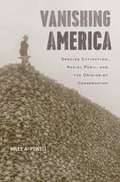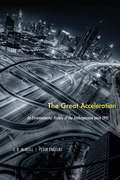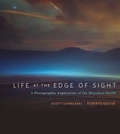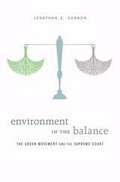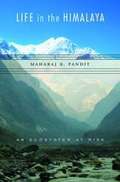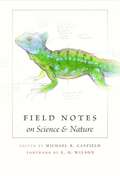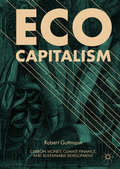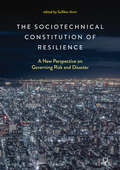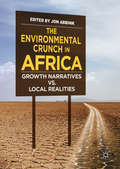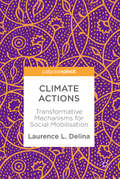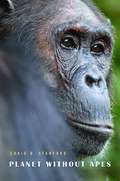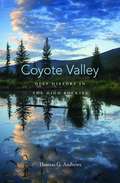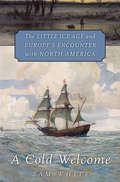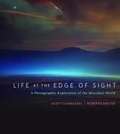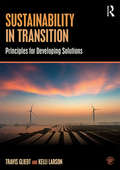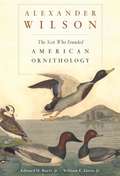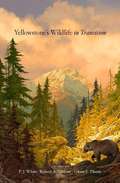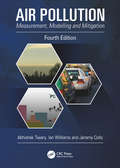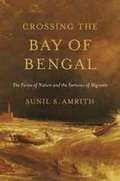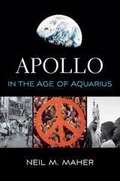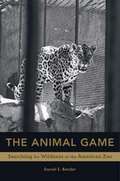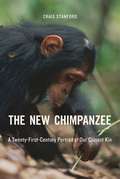- Table View
- List View
Vanishing America: Species Extinction, Racial Peril, And The Origins Of Conservation
by Miles A. PowellMiles Powell explores how early conservationists became convinced that the vitality of America’s white races depended on preserving the wilderness. Some conservationists embraced scientific racism, eugenics, and restrictive immigration laws, but these activists also laid the groundwork for the many successes of the modern environmental movement.
The Great Acceleration: An Environmental History Of The Anthropocene Since 1945
by J. R. McNeillThe pace of energy use, greenhouse gas emissions, and population growth has thrust the planet into a new age—the Anthropocene. Humans have altered the planet’s biogeochemical systems without consciously managing them. The Great Acceleration explains the causes, consequences, and uncertainties of this massive uncontrolled experiment.
Life at the Edge of Sight: A Photographic Exploration of the Microbial World
by Scott Chimileski Roberto Kolter Moselio SchaechterThis stunning photographic essay opens a new frontier for readers to explore through words and images. Microbial studies have clarified life’s origins on Earth, explained the functioning of ecosystems, and improved both crop yields and human health. Scott Chimileski and Roberto Kolter are expert guides to an invisible world waiting in plain sight.
Environment in the Balance: The Green Movement And The Supreme Court
by Jonathan Z. CannonDoes the green movement remain a transformative force in American life? In Environment in the Balance Jonathan Cannon interprets a wide range of U.S. Supreme Court decisions over four decades and explores the current ferment among activists, to gauge the practical and cultural impact of environmentalism and its future prospects.
Life in the Himalaya: An Ecosystem at Risk
by Maharaj K. PanditThe collision of the Indian and Eurasian plates 50 million years ago created the Himalaya, along with massive glaciers, intensified monsoon, turbulent rivers, and an efflorescence of ecosystems. Today, the Himalaya is at risk of catastrophic loss of life. Maharaj Pandit outlines the mountain’s past in order to map a way toward a sustainable future.
Field Notes on Science & Nature
by Michael R. CanfieldWhat did George Schaller note when studying the lions of the Serengeti? How does Piotr Naskrecki use relational databases and electronic field notes? In what way is Bernd Heinrich’s approach “truly Thoreauvian,” in E. O. Wilson’s view? Pioneering a new niche in the study of plants and animals in their native habitat, Field Notes on Science and Nature allows readers to peer over the shoulders and into the notebooks of a dozen eminent field workers, to study firsthand their methods, materials, and fleeting impressions. Recording field observations is an indispensable scientific skill, but researchers are not generally willing to share their personal records. Here, for the first time, are reproductions of actual pages from notebooks. And in essays abounding with fascinating anecdotes, the authors reflect on the contexts in which the notes were taken. Covering disciplines as diverse as ecology, paleontology, anthropology, botany, and animal behavior, Field Notes offers specific examples that professional naturalists can emulate to fine-tune their own field methods, along with practical advice that amateur naturalists and students can use to document their adventures.
Eco-Capitalism (PDF)
by Robert GuttmannOur planet faces a systemic threat from climate change, which the world community of nations is ill-prepared to address, and this book argues that a new form of ecologically conscious capitalism is needed in order to tackle this serious and rising threat. While the Paris Climate Agreement of 2015 has finally implemented a global climate policy regime, its modest means belie its ambitious goals. Our institutional financial organizations are not equipped to deal with the problems that any credible commitment to a low-carbon economy will have to confront. We will have to go beyond cap-and-trade schemes and limited carbon taxes to cut greenhouse gas emissions substantially in due time. This book offers a way forward toward that goal, with a conceptual framework that brings environmental preservation back into our macro-economic growth and forecasting models. This framework obliges firms to consider other goals beyond shareholder value maximization, outlining the principal tenets of a climate-friendly finance and introducing a new type of money linked to climate mitigation and adaptation efforts.
The Sociotechnical Constitution of Resilience: A New Perspective on Governing Risk and Disaster
by Sulfikar AmirThis book considers the concept of resilience in a global society where coping with the consequence and long term impact of crisis and disaster challenges the capacity of communities to bounce back in the event of severe disruption. Catastrophic events such as the 9.11 terrorist attack, the Fukushima nuclear disaster, and the volcano eruption in Central Java entailed massive devastation on physical infrastructures, and caused significant social and economic damage. This book considers how the modern sociotechnological system facilitating human activity defines how societies survive and whether a crisis will be short-lived or prolonged. Drawing on the concept of sociotechnical resilience, this book closely examines a range of events North America, Asia, Australia, and Europe. By presenting the successes and failures of sociotechnical resilience, it offers important insights and practical lessons to build better and comprehensive understandings of resilience in a real-world setting, significantly contributing to the study of disaster resilience.
The Sociotechnical Constitution of Resilience: A New Perspective on Governing Risk and Disaster
by Sulfikar AmirThis book considers the concept of resilience in a global society where coping with the consequence and long term impact of crisis and disaster challenges the capacity of communities to bounce back in the event of severe disruption. Catastrophic events such as the 9.11 terrorist attack, the Fukushima nuclear disaster, and the volcano eruption in Central Java entailed massive devastation on physical infrastructures, and caused significant social and economic damage. This book considers how the modern sociotechnological system facilitating human activity defines how societies survive and whether a crisis will be short-lived or prolonged. Drawing on the concept of sociotechnical resilience, this book closely examines a range of events North America, Asia, Australia, and Europe. By presenting the successes and failures of sociotechnical resilience, it offers important insights and practical lessons to build better and comprehensive understandings of resilience in a real-world setting, significantly contributing to the study of disaster resilience.
The Environmental Crunch in Africa
by Jon AbbinkThis book discusses the problems and challenges of environmental–ecological conditions in Africa, amidst the current craze of economic growth and ‘development’. Africa’s significant economic dynamics and growth trajectories are marked by neglect of the environment, reinforcing ecological crises. Unless environmental–ecological and population growth problems are addressed as an integral part of developmental strategies and growth models, the crises will accelerate and lead to huge costs in later years. Chapters examine multiple emerging tension points all across the continent, including the potential benefits and harm of growing urban-based ecotourism, the trajectory of labour-saving technologies and the problems facing agro-pastoralism. Although environmental management and sustainability features of African rural societies should not be idealized, functional 'traditional' economies, interests and management practices are often bypassed, seen by state elites as inefficient and inhibiting 'growth'. In many regions the seeds are now sown for lasting environmental crises that will affect local societies that have rarely been given opportunity to claim accountability from the state regimes and donors driving these changes.
Climate Actions
by Laurence L DelinaClimate change remains a challenge that needs to be addressed at its core, particularly the rapid reduction of anthropogenic greenhouse gas emissions. This book discusses strategies for climate actions by synthesizing insights from a set of international ‘contemporary social action group’s’ surveys. Based on these Delina introduces a synthesis of mechanisms for generating change, designed around 5 main themes: relationships (relating); value-based messages (messaging); alternatives (visioning); diversity (webbing); and communication (interacting). This book will be of great value to all academics and practitioners interested in the future development of our climate.
Planet Without Apes
by Craig B. StanfordCan we live with the consequences of wiping our closest relatives off the face of the Earth, and all the biological knowledge about ourselves that would die along with them? Extinction of the great apes threatens to become a reality within a few human generations. Stanford tells us how we can redirect the course of an otherwise bleak future.
Coyote Valley: Deep History in the High Rockies
by Thomas G. AndrewsThomas Andrews drills deep into the many pressures that have reshaped a small stretch of North America, from the ice age to the advent of the Anthropocene and controversies over climate change. He brings to the surface lessons about the critical relationships to land, climate, and species that only seemingly unimportant places on Earth can teach.
Deepwater Horizon: A Systems Analysis Of The Macondo Disaster
by Earl Boebert James M. BlossomIn 2010 BP’s Deepwater Horizon catastrophe spiraled into the worst human-made economic and ecological disaster in Gulf Coast history. In the most comprehensive account to date, senior systems engineers Earl Boebert and James Blossom show how corporate and engineering decisions, each one individually innocuous, interacted to create the disaster.
A Cold Welcome: The Little Ice Age and Europe’s Encounter with North America
by Sam WhiteWhen Europeans arrived in North America, the average global temperature had dropped to lows unseen in millennia and its effects—famine, starvation, desperation, and violence—were stark among colonists unprepared to fend for themselves. This history of the Little Ice Age in North America reminds us of the risks of a changing and unfamiliar climate.
Life at the Edge of Sight: A Photographic Exploration of the Microbial World
by Scott Chimileski Roberto Kolter Moselio SchaechterThis stunning photographic essay opens a new frontier for readers to explore through words and images. Microbial studies have clarified life’s origins on Earth, explained the functioning of ecosystems, and improved both crop yields and human health. Scott Chimileski and Roberto Kolter are expert guides to an invisible world waiting in plain sight.
Sustainability in Transition: Principles for Developing Solutions
by Travis Gliedt Kelli LarsonSustainability in Transition: Principles for Developing Solutions offers the first in-depth education-focused treatment of how to address sustainability in a comprehensive manner. The textbook is structured as a learning-centered approach to walk students through the process of linking sustainable behavior and decision-making to green innovation systems and triple-bottom-line economic development practices, in order to achieve sustainable change in incremental to transformational ways. All chapters combine theory and practice with the help of global case study and research study examples to illustrate barriers and best practices. Each chapter begins with learning objectives and ends with a 'check on learning' section that ties the main points back to the core themes of the book. Chapters include a section focused on measuring progress and a box comparing international research or case studies to the North American focus of the chapter. A list of additional academic sources for students that complement each chapter is included. Building sustainability tools, techniques, and competencies cumulatively with the help of problem- and project-based learning modules, Sustainability in Transition: Principles for Developing Solutions is a comprehensive resource for learning sustainability theory and doing sustainability practice. It will be essential reading for advanced undergraduate and graduate level students who have already completed introductory sustainability classes.
Alexander Wilson: The Scot Who Founded American Ornithology
by Edward H. Burtt Jr.On the bicentennial of his death, this beautifully illustrated volume pays tribute to the Scot who became the father of American ornithology. Alexander Wilson made unique contributions to ecology and animal behavior. His drawings of birds in realistic poses in their natural habitat inspired Audubon, Spencer Fullerton Baird, and other naturalists.
Yellowstone's Wildlife in Transition
by P. J. WhiteThe world's first national park is constantly changing. How we understand and respond to recent events putting species under stress will determine the future of ecosystems millions of years in the making. Marshaling expertise from over 30 contributors, Yellowstone's Wildlife in Transition examines three primary challenges to the park's ecology.
Air Pollution: Measurement, Modelling and Mitigation, Fourth Edition
by Ian Williams Abhishek TiwaryThis established textbook offers a one-stop, comprehensive coverage of air pollution, all in an easy-reading and accessible style. The fourth edition, broadly updated and developed throughout, includes a brand-new chapter providing a broader overview to the topic for general reading, and presents fresh materials on air pollution modelling, mitigation and control, tailored to the needs of both amateur and specialist users. Retaining a quantitative perspective, the covered topics include: gaseous and particulate air pollutants, measurement techniques, meteorology and modelling, area sources, mobile sources, indoor air, effects on plants, materials, humans and animals, impact on climate change and ozone profiles and air quality legislations. This edition also includes a final chapter covering a suite of sampling and laboratory practical experiments that can be used for either classroom teachings, or as part of research projects. As with previous editions, the book is aimed to serve as a useful reading resource for upper-level undergraduate and postgraduate courses specialising in air pollution, with dedicated case studies at the end of each chapter, as well as a list of revision questions provided at the end as a complementary section.
Crossing the Bay of Bengal: The Furies Of Nature And The Fortunes Of Migrants
by Sunil S. AmrithFor centuries the Bay of Bengal served as a maritime highway between India and China, and as a battleground for European empires, while being shaped by monsoons and human migration. Integrating environmental history and mining a wealth of sources, Sunil S. Amrith offers insights to the many challenges facing Asia in the decades ahead.
Apollo in the Age of Aquarius
by Neil M. MaherIn summer 1969, astronauts landed on the moon and hippie hordes descended on Woodstock—two era-defining events that are not entirely coincidental. Neil M. Maher shows how NASA’s celestial aspirations were tethered to terrestrial concerns of the time: the civil rights struggle, the antiwar movement, environmentalism, feminism, and the culture wars.
Bee Time: Lessons from the Hive
by Mark L. WinstonBeing among bees is a full-body experience, Mark Winston writes. Bee Time presents his reflections on three decades spent studying these remarkable creatures, and on the lessons they can teach about how humans might better interact with one another and the natural world, from the boardroom to urban design to agricultural ecosystems.
The Animal Game: Searching For Wildness At The American Zoo
by Daniel E. BenderTracing the global trade and trafficking in animals that supplied U.S. zoos, Daniel Bender shows how Americans learned to view faraway places through the lens of exotic creatures on display. He recounts the public’s conflicted relationship with zoos, decried as prisons by activists even as they remain popular centers of education and preservation.
The New Chimpanzee: A Twenty-First-Century Portrait of Our Closest Kin
by Craig StanfordRecent discoveries about wild chimpanzees have dramatically reshaped our understanding of these great apes and their kinship with humans. We now know that chimpanzees not only have genomes similar to our own but also plot political coups, wage wars over territory, pass on cultural traditions to younger generations, and ruthlessly strategize for resources, including sexual partners. In The New Chimpanzee, Craig Stanford challenges us to let apes guide our inquiry into what it means to be human. With wit and lucidity, Stanford explains what the past two decades of chimpanzee field research has taught us about the origins of human social behavior, the nature of aggression and communication, and the divergence of humans and apes from a common ancestor. Drawing on his extensive observations of chimpanzee behavior and social dynamics, Stanford adds to our knowledge of chimpanzees’ political intelligence, sexual power plays, violent ambition, cultural diversity, and adaptability. The New Chimpanzee portrays a complex and even more humanlike ape than the one Jane Goodall popularized more than a half century ago. It also sounds an urgent call for the protection of our nearest relatives at a moment when their survival is at risk.
